
A phase II trial found that use of a personalized peptide vaccination improved overall survival in patients with chemotherapy-resistant advanced urothelial bladder cancer.

Your AI-Trained Oncology Knowledge Connection!


A phase II trial found that use of a personalized peptide vaccination improved overall survival in patients with chemotherapy-resistant advanced urothelial bladder cancer.

In most cases, localized small-cell bladder cancer requires cystectomy for optimal cure rates.

Radiation therapy with concurrent chemotherapy is an effective treatment strategy for small-cell bladder cancer.

Use of the diabetes drug pioglitazone was not associated with a significantly increased risk of bladder cancer, in a large cohort study.
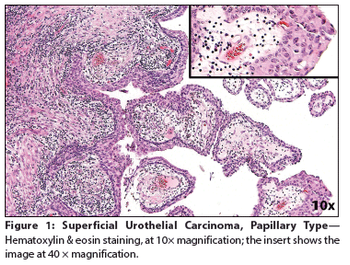
A 65-year-old woman presented to a local emergency department complaining of right flank pain that had worsened over the past 10 days. A CT scan of the abdomen and pelvis showed intravesical tumors of the urinary bladder.

Pembrolizumab demonstrates durable antitumor activity in patients with advanced urothelial cancer, with a higher response rate seen in patients with PD-L1 expression.

Advanced bladder cancer patients with poor prognosis appear to benefit from adding apatorsen 600 mg to first-line chemotherapy with gemcitabine/cisplatin.

Presentation with a urinary tract infection delayed a bladder cancer diagnosis among a population of Medicare patients, with worse delays experienced by women.

Phase II study results found that half of patients with relapsed or refractory urothelial carcinoma responded to treatment with pazopanib and paclitaxel.

In this interview we discuss the changing landscape of systemic therapies for the treatment of bladder cancer.
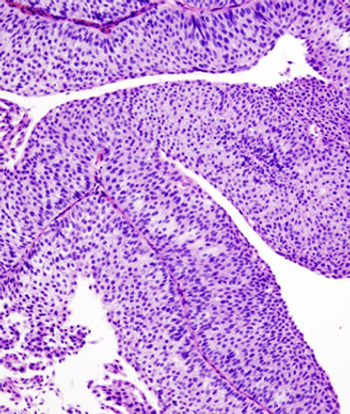
Patients with bladder cancer derived an overall survival benefit from the use of adjuvant chemotherapy compared with observation.

A urine test (CellDetect) was able to detect disease recurrence in bladder cancer patients, with a reported sensitivity of 84.4% and specificity of 82.7%.

While observation may be appropriate for select cases where prognosis is poor, rates of non-treatment are unacceptably high in muscle-invasive bladder cancer.

Long-term survival rates of patients after laparoscopic surgery for bladder cancer are similar to rates achieved with standard open surgery.

An extremely large database study across more than one million people found no increased risk of bladder cancer with the diabetes drug pioglitazone.

A large phase I study showed that the PD-L1 antibody known as MPDL3280A has promising activity in patients with urothelial bladder cancer.

Cancer survivors are at an increased risk for developing a second smoking-associated cancer if they smoked cigarettes prior to their first cancer diagnosis.

Bladder neoplasms are associated with a high frequency of painless hematuria; however, when compared with the bleeding tendencies of other solid tumors, it is arguable that this comparatively high bleeding frequency is in part the result of an ascertainment bias.
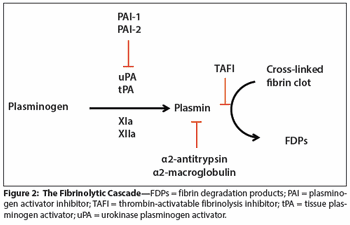
Overall, approximately 2% of patients with bladder cancer will experience a venous thromboembolism event, a rate five times higher than that in the overall population; also, such an event results in a threefold increased risk of death in patients with cancer.

Cancer promotes the development of venous thromboembolism (VTE) by inducing a hypercoaguable state, through mechanisms that are complex and multifactorial.

Despite the higher risk of VTE in patients with bladder cancer, ironically, their risk of bleeding and anemia, and greater need for transfusion of blood products, poses an equally significant risk of morbidity and mortality, especially among those who undergo cystectomy.

Immediate adjuvant cisplatin-based combination chemotherapy after radical cystectomy in patients with transitional cell carcinoma of the bladder significantly increased progression-free survival, according to the final results of the EORTC 30994 trial.
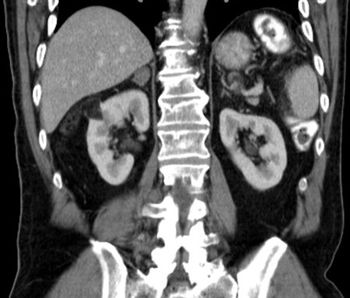
A reduced estimated glomerular filtration rate (eGFR) was found to be associated with a significantly increased risk for renal and urothelial cancer, according to the results of a recently published study.

An increased intake of vitamin A may result in a decreased risk for bladder cancer, according to the results of a meta-analysis.
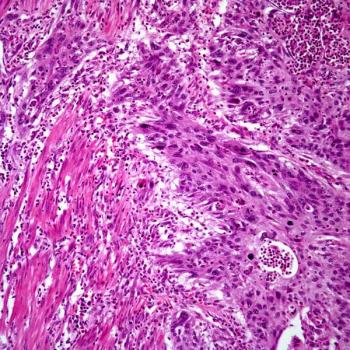
Neoadjuvant treatment with dose-dense methotrexate, vinblastine, doxorubicin, and cisplatin was well tolerated and should be considered a reasonable option for patients with muscle-invasive urothelial cancer, according to a new study.